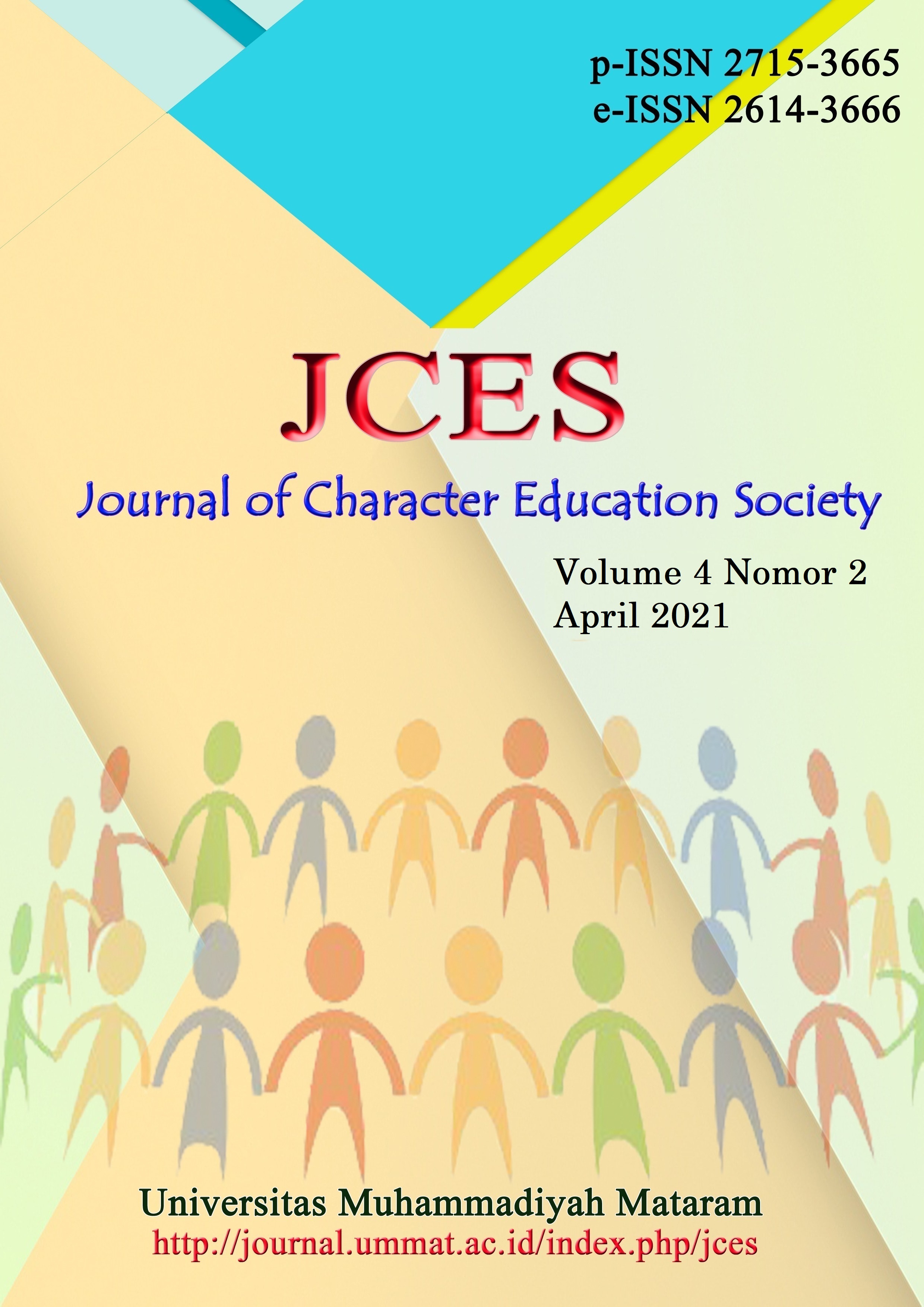DEVELOPMENT ENTERPRENEURSHIP THROUGH INOVATION OF "CILOK-GURITA (Octopus sp.)" AS A NUTRIOUS FOOD
DOI:
https://doi.org/10.31764/jces.v4i2.4154Keywords:
Entrepreneurship, Cilok, Octopus Sp, Nutrition.Abstract
Abstrak: Cilok yang beredar di masyarakat selama ini adalah cilok yang berbahan dasar daging, akan tetapi harga daging tergolong mahal, sehingga perlunya inovasi baru berupa cilok yang berbahan dasar murah namun memiliki nilai gizi yang tinggi. Cilok gurita (Octopus sp) kaya gizi merupakan solusi yang dapat dikembangkan sebagai keterbaruan inovasi pangan dimasa sekarang ini. Tujuan kegiatan ini adalah untuk menciptakan peluang usaha mandiri melalui produksi cilok gurita yang sehat dan mempunyai nilai gizi yang tinggi bagi semua golongan masyarakat. Metode yang digunakan adalah praktek langsung pembuatan cilok gurita dan menganalisis kelayakan usahanya. Produksi cilok gurita meliputi kegiatan pembuatan produk, pengemasan, dan juga pemasaran kepada konsumen. Cilok Gurita ini terdiri atas berbagai rasa dengan harga jual per porsi (1 mika berisikan 6 pcs) adalah Rp. 5.000,-. Strategi pemasaran yang digunakan adalah secara daring melalui media social whatsapp. Hasil perhitungan cash flow menunjukan bahwa usaha cilok gurita akan mengalami kenaikan kas sebesar Rp.50.000 ketika penjualan mencapai 50 porsi. Usaha cilok gurita ini layak untuk bersaing di pasaran karena penjualan dalam kurun waktu 1 bulan sudah dapat melebihi BEP.
Abstract: The cilok that has been circulating in the community so far has been the cilok made from meat, but the price of meat is quite expensive, so there is a need for new innovations in the form of cilok made from cheap but high nutritional value. Nutrient-rich Cilok Octopus (Octopus sp) is a solution that can be developed as a novelty in today's food innovations. The purpose of this activity is to create independent business opportunities through the production of healthy octopus peelings that have high nutritional value for all groups of society. The method used is direct practice of making octopus peel and analyzing the feasibility of its business. The production of cilok octopus includes product manufacturing, packaging, and marketing to consumers. Cilok Octopus consists of various flavors with a selling price per serving (1 mica contains 6 pcs) is Rp. 5,000, -. The marketing strategy used is online via whatsapp social media. The results of the cash flow calculation show that the octopus peel business will experience an increase in cash of IDR 50,000 when sales reach 50 portions. This octopus peel business is feasible to compete in the market because sales within 1 month can exceed BEP.
References
Apriyana. (2014). Pengaruh Penambahan Tepung Kepala Ikan Lele (Clarias Sp) dalam Pembuatan Cilok terhadap Kadar Protein dan Sifat Organoleptiknya. Unnes Journal of Public Health, 3(2), 1–9. https://doi.org/10.15294/ujph.v3i2.3529
Asnidar, Lahming, & andi sukainah. (2019). Analisis Mutu Sosis Gurita (Octopus sp). Αγαη, 5(2), 72–82. https://doi.org/10.22201/fq.18708404e.2004.3.66178
Bustami, Bastian, & Nurlaela. (2013). Akuntasi Biaya. In Mitra Wacana Media. Mitra Wacana Media.
Faoziyah, A. R., Agustina, L. T., & Wijaya, T. H. (2019). Jurnal Ilmiah Kefarmasian. Jurnal Ilmiah Kefarmasian, 65–70.
Fauziah, R. R., Lovabyta, N. S., & Wahyuningtyas, W. S. (2016). Pembuatan Ciweed (Cilok-Seaweed) sebagai Alternatif Pangan Sehat dan Bergizi. Agroteknologi, 10(02), 160–166.
Indika, D. R., & Jovita, C. (2017). Media Sosial Instagram Sebagai Sarana Promosi Untuk Meningkatkan Minat Beli Konsumen. Jurnal Bisnis Terapan, 1(01), 25–32. https://doi.org/10.24123/jbt.v1i01.296
Malombeke, M. B. (2013). Analisa Break-Even-Point Sebagai Dasar Perencanaan Laba Holland Bakery Manado. Jurnal EMBA, 1(3), 806–817.
Ngabalin, D., Talakua, E. G., & Pentury, F. (2018). Pengembangan Usaha Pengolahan Gurita dan Cacing Laut Kering di Ohoi Matwair, Kecamatan Kei Kecil Barat. Jurnal Ilmiah Pengabdian Kepada Masyarakat, 4(2), 118–124.
Nugrahani, N. (2013). 2008. Identifikasi Aspek-aspek Pemasaran dalam Perencanaan Bisnis Kemitraan antara Penjual dengan Petani Beras Organik. Tesis. Program Magister Manajemen Fakultas Bisnis dan Manajemen, Universitas Widyatama, Bandung. Jurnal Optimal, 1(2), 23–30.
Ristovska, N., & Stoilkovska, Aleksandra Gramatnikovski, S. (2015). Innovative business models a factor for competitive advantage of the companies. UTMS Journal of Economics, 6(1), 135–146.
Riyanto, B., Trilaksani, W., & Lestari, R. (2016). Minuman Nutrisi Olahraga Berbasis Hidrolisat Protein Gurita. Jphpi 2016, 19(3), 339–347. https://doi.org/10.17844/jphpi.2016.19.3.339
Rohmah, N. K., & Handayani, S. (2013). Kajian Kemanan Pangan Pentol Cilok di Desa Blawirejo Kecamatan Kedungpring Lamongan. Jurnal Tata Boga UNESA, 2(1), 58–65.
Sodikin. (2015). Akuntansi Manajemen. In UPP STIM YKPM.
Susanto, A. H., Ridho, R., & Sulistiono. (2019). Pemanfaatan Limbah Tulang Ikan Tuna Dalam Pembuatan Cilok Sebagai Sumber Kalsium. Lemuru, 1, 25–32.
Wibowo, D. H., Arifin, Z., & Sunarti, . (2015). Analisis Strategi Pemasaran Untuk Meningkatkan Daya Saing UMKM (Studi pada Batik Diajeng Solo). Jurnal Administrasi Bisnis, 29(1), 59–66.
Downloads
Published
Issue
Section
License
Authors who publish articles in JCES (Journal of Character Education Society) agree to the following terms:
- Authors retain copyright of the article and grant the journal right of first publication with the work simultaneously licensed under a CC-BY-SA or The Creative Commons Attribution–ShareAlike License.
- Authors are able to enter into separate, additional contractual arrangements for the non-exclusive distribution of the journal's published version of the work (e.g., post it to an institutional repository or publish it in a book), with an acknowledgment of its initial publication in this journal.
- Authors are permitted and encouraged to post their work online (e.g., in institutional repositories or on their website) prior to and during the submission process, as it can lead to productive exchanges, as well as earlier and greater citation of published work (See The Effect of Open Access).

